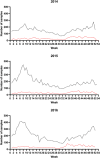Epidemiology and clinical manifestations of different enterovirus and rhinovirus types show that EV-D68 may still have an impact on severity of respiratory infections
- PMID: 35403229
- PMCID: PMC9321759
- DOI: 10.1002/jmv.27767
Epidemiology and clinical manifestations of different enterovirus and rhinovirus types show that EV-D68 may still have an impact on severity of respiratory infections
Abstract
Respiratory infections are often caused by enteroviruses (EVs). The aim of this study was to identify whether certain types of EV were more likely to cause severe illness in 2016, when an increasing spread of upper respiratory infections was observed in Gothenburg, Sweden. The EV strain in 137 of 1341 nasopharyngeal samples reactive for EV by polymerase chain reaction could be typed by sequencing the viral 5'-untranslated region and VP1 regions. Phylogenetic trees were constructed. Patient records were reviewed. Hospital care was needed for 46 of 74 patients with available medical records. The majority of the patients (83) were infected with the rhinovirus (RV). The remaining 54 were infected with EV A, B, C, and D strains of 13 different types, with EV-D68 and CV-A10 being the most common (17 vs. 14). Significantly more patients with EV-D68 presented with dyspnea, both when compared with other EV types (p = 0.003) and compared to all other EV and RV infections (p = 0.04). Phylogenetic analysis of the sequences revealed the spread of both Asian and European CV-A10 strains and 12 different RV C types. This study showed an abundance of different EV types spreading during a year with increased upper respiratory increased infections. EV-D68 infections were associated with more severe disease manifestation. Other EV and RV types were more evenly distributed between hospitalized and nonhospitalized patients. The EV type CV-A10 was also found in infected patients, which warrants further studies and surveillance, as this pathogen could cause more severe disease and outbreaks of hand, foot, and mouth disease.
Keywords: CV-A10; enterovirus; epidemiology; phylogeny; rhinovirus.
© 2022 The Authors. Journal of Medical Virology published by Wiley Periodicals LLC.
Conflict of interest statement
The authors declare no conflicts of interest.
Figures




References
-
- Chuang Y‐Y, Huang Y‐C. Enteroviral infection in neonates. J Microbiol Immunol Infect. 2019;52:851‐857. - PubMed
MeSH terms
LinkOut - more resources
Full Text Sources

